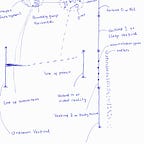Sentience, LLMs: Does the Brain Refute Panpsychism’s Consciousness?
There is a recent piece in Scientific American, Is Consciousness Part of the Fabric of the Universe?, reporting that, “Scholars recently gathered to debate the problem at Marist College in Poughkeepsie, N.Y., during a two-day workshop focused on an idea known as panpsychism. The concept proposes that consciousness is a fundamental aspect of reality, like mass or electrical charge. The idea goes back to antiquity — Plato took it seriously — and has had some prominent supporters over the years, including psychologist William James and philosopher and mathematician Bertrand Russell.”
“Yet panpsychism runs counter to the majority view in both the physical sciences and in philosophy that treats consciousness as an emergent phenomenon, something that arises in certain complex systems, such as human brains. In this view, individual neurons are not conscious, but thanks to the collective properties of some 86 billion neurons and their interactions — which, admittedly, are still only poorly understood — brains (along with bodies, perhaps) are conscious.”
A few questions before exploring panpsychism.
Why do psychiatric drugs have side effects? These medications are known to induce or inhibit the availability of some monoamines at synaptic clefts.
Is serotonin the human mind? Or, is dopamine? When dopamine is said to play a role in learning, motivation, movement and reward, does dopamine go it alone, where for example, it is possible to increase dopamine then understand better than others? Does dopamine act alone, or does it contribute, even if it may have an outsize stake?
There are clusters of neurons in the brain. They lead functions. These clusters are connected. They send fibers within and elsewhere, others do the same. But why are there clusters? Why are neurons connected? Why are they in large numbers? Why is the cerebral cortex corrugated? Why does one neuron have thousands of connections? Why are some functions possible across different areas? Why does neuroplasticity occur?
The brain is clearly not an individual system, where a neurotransmitter or neuron decides. If there are no individual decisions in the brain, for the complex outcomes of human existence, why should electrons be considered for consciousness in panpsychism?
There are associations, but associations do not mean inclusion in the same groups. That molecules consist of atoms that consist of electrons — with their properties does not mean that electrons have an inner life, or contribute as they are to the frontline of consciousness.
Neurotransmitters matter, but they don’t have the last word, individually. There could be reductions, but the brain that gives consciousness works in groups. The consciousness of panpsychism may be everywhere, but it cannot be compared to what the brain provisions.
If consciousness is rated at 1, for humans, for all the possible ways for being and experience — like emotions, feelings, memories, intelligence, language, thoughts, regulations and so forth, then other organisms have less than 1.
If panpsychism will be considered, they can go from -100 to -1, on a negligible scale.
How does the brain combine its constituents to have consciousness? It is proposed that electrical and chemical impulses are central in all conscious experiences. They are in loops or sets, where they interact and have features. The loops are arrayed, contributing to order.
These loops are proposed to hold the formation wherewith interpretations of sensory inputs are based. These loops also have the sense of self, as well as spaces that allow for control or intentionality.
There are other features of loops of impulses.
LLMs do not have biological mechanisms, but they have an output of knowing that fits with some subdivisions of human consciousness. They may not understand, but what they churn out can be rated low, on the human scale.
If automobiles were conscious as in panpsychism, they would not need AI for some level of autonomy. Panpsychism offers negligible consciousness. Common atomic components do not mean outcomes of the brain and objects can be grouped, or closely calibrated, in relationship to mind, or for consciousness.
